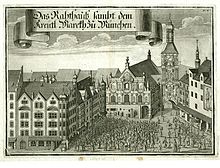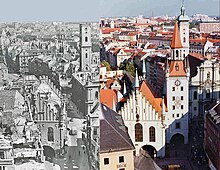Old Town Hall (Munich)
The old town hall on Marienplatz is a representative building of the city administration in Munich's old town . It was built from 1470 to 1475 by Jörg von Halsbach in the late Gothic style and was the seat of the Munich magistrate until 1874 .
location
The old town hall closes the Marienplatz to the east and separates it from the street Tal at the former moat of the so-called "Leonian city fortification" of Henry the Lion .
history


The Old Town Hall is a successor to the Munich Town Hall, first mentioned in a document in 1310, which stood further to the west because of the city fortifications, which at that time still ended at Marienplatz, but already formed the eastern end of the central Münchner Platz. As early as 1392/94, this building received a large hall, and the Talburg gate of the first city wall , which was originally called the Lower Gate , was converted into a town hall tower.
The former festival and dance hall
In 1460 the entire complex, of which there is a very good description but no images are known, fell victim to a lightning strike. Between 1470 and 1480, master builder Jörg von Halsbach , called “Ganghofer”, built his late Gothic town hall. The city prison ( Fronhaus ) was housed in the basement and the bread house on the ground floor. The gable to the market had very few very large steps even before the early baroque renovation (see below).
The first floor was expanded as a central room into a festival and dance hall. The hall building, whose late Gothic room with a barrel vault by Hans Wengler from 1476 was one of the architectural masterpieces of the Munich Gothic , was decorated by Erasmus Grasser with the coat of arms of the House of Wittelsbach. The double-headed imperial eagle appears in the center. The surrounding halo was in cosmic relation to the sun and moon, each at the end of the hall. A painted coat of arms frieze on the north and south side of the hall represented “the powers of order and rule of the world” at that time. However, the “ Morisk dancers ” created by Grasser , who represented the dance very popular in the 15th century, are particularly worth mentioning . Today there are only copies in the ballroom, the originals are one of the most valuable possessions of the Munich City Museum . In addition to the civic events, the town hall was also used as a place of representation for the rulers.
Further changes
The old town hall has undergone several redesigns over the centuries, which arose from the respective taste of the time: 1624 ~ 1626 the facade was redesigned in Baroque style, the town hall tower received an onion dome . In 1778/79 Augustin Demmel changed the west facade in the late Baroque style (H. Habel: "Louis XIV"), Arnold Zenetti regotized the town hall from 1861 to 1864 in the spirit of historicism . The neo-Gothic crenellated gable with many steps that was built at that time does not correspond to the representation of the original Gothic gable in the Volckmer plan from 1613. The Ganghofer's hall has always remained untouched.
After the city administration had moved to the first construction phase of the New Town Hall in 1874 and the building, now known as the Old Town Hall , was mainly used for representative occasions, a passage to the valley with a separate pedestrian passage was broken through on the ground floor . In 1934/35 today's passage was extended over the entire ground floor in the form of the Gothic architectural style, which finally destroyed the parterre zone.
National Socialism, War and Reconstruction
During the Second World War, the old town hall was particularly hard hit. The tower of the old town hall was blown up in December 1944 after the old town hall was badly damaged in a bomb attack on April 25, 1944 and the town hall tower was in danger of collapsing. The reconstruction then took place in two phases: 1953 to 1958 the hall of the old town hall was rebuilt, whereby the Ganghofer'sche hall was the core of the reconstruction. The council chamber was not reconstructed until 1977. In the facade design, the monument preservationists based themselves on the Gothic original; so the main window became higher again; the neo-Gothic elements, especially the statues of Ludwig of Bavaria (west facade) and Henry the Lion (east facade) and the design of the gable were preserved.
A possible reconstruction of the Talburg tower was discussed in public for a long time, finally Erwin Schleich reconstructed the 56 meter high old town hall tower from 1971 to 1974 based on the Gothic original from 1493. In the octagon of the tower top hangs a bronze bell from the Erdingen bell foundry with a strike tone d 1 , which is closed every half and full hour is struck.
The so-called Small Town Hall , a medieval annex to the tower, which had been redesigned in a neo-Gothic style and had ornate gables and chimneys, was completely a victim of the war .
Historical events in the old town hall
The following important historical events took place:
- 1677 venue of the Bavarian Parliament
- 1848 Election of the Munich deputies for the Frankfurt National Assembly
- November 9, 1938: Speech by Joseph Goebbels , which is considered the prelude to the Reichspogromnacht .
Functions
The Gothic hall of the old town hall is today the place of representation of the city council and the mayor of the state capital. Awards such as the “ Munich shines ” medal are presented in the old town hall. But the hall can also be rented for private purposes.
Toy museum
The tower of the old town hall houses the toy museum with the Ivan Steiger collection, which has been housed here since 1983 . In this private museum you can see wooden and tin toys, dolls (including Barbie dolls), teddy bears, trains and steam engines. The museum is a family business that has been run by Ivan Steiger's daughter, Helena Steiger, since 2020. The family also runs a toy museum in Prague .
Significant works
-
Council Chamber ( Jörg von Halsbach , 1470–1480) with
- Carving of the wooden barrel ceiling (Hans Wenger, 1476/77)
- Coat of arms frieze (99 city coats of arms) in the fighting zone of the vault (Ulrich Fuetrer)
- Morris dancer (originally for the ballroom of the old town hall by Erasmus Grasser , around 1480) (copies, originals in the Munich City Museum )
- Statue of Ludwig of Bavaria ( Konrad Knoll )
- Henry the Lion statue (Konrad Knoll)
literature
- Heinrich Habel, Johannes Hallinger, Timm Weski: State capital Munich - center (= Bavarian State Office for Monument Preservation [Hrsg.]: Monuments in Bavaria . Volume I.2 / 1 ). Karl M. Lipp Verlag, Munich 2009, ISBN 978-3-87490-586-2 , p. 556-564 .
- Klaus Gallas : Munich. From the Guelph foundation of Henry the Lion to the present: art, culture, history . DuMont, Cologne 1979, ISBN 3-7701-1094-3 (DuMont documents: DuMont art travel guide).
- LH Munich (Ed.): New and Old Munich City Hall
- Munich City Museum: The Morisk Dancers
Web links
- muenchen.de: Old Town Hall
- Restoration of the old town hall (Allgemeine Bauzeitung) on Anno (Austrian Newspapers Online)
Individual evidence
- ↑ See LH Munich, p. 45 or Stadtmuseum München: “The global horizon of the former imperial and now newly articulated claim to power was marked out by a frieze of almost a hundred additional coats of arms”.
- ↑ See LH Munich, p. 44f
- ^ Heinrich Habel: Monument topography of the city of Munich
- ↑ Stadtreparatur Altes Rathaus: Photograph from April 27, 1944 and text ( Memento of the original from March 10, 2012 in the Internet Archive ) Info: The archive link has been inserted automatically and has not yet been checked. Please check the original and archive link according to the instructions and then remove this notice.
- ↑ http://www.spielzeugmuseummuenchen.de Toy museum in the old town hall tower
- ↑ Theresa Parstorfer: In children's paradise, in: Süddeutsche Zeitung of 30 January 2020 R6
- ↑ http://www.ivansteiger.de/czech/ Homepage Toy Museum in Prague
Coordinates: 48 ° 8 ′ 12 ″ N , 11 ° 34 ′ 37 ″ E












